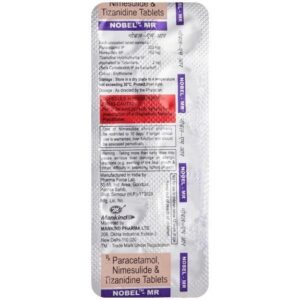NIMESULIDE + TIZANIDINE + PARACETAMOL
Nimesulide: Nimesulide is a nonsteroidal anti-inflammatory drug (NSAID) that is commonly used to relieve pain, inflammation, and fever. It belongs to the class of selective COX-2 inhibitors and has both analgesic and antipyretic properties.
The mechanism of action of Nimesulide involves inhibiting the production of prostaglandins, which are substances that cause pain, inflammation, and fever. By selectively targeting the COX-2 enzyme, Nimesulide reduces the production of prostaglandins without affecting the COX-1 enzyme, which is responsible for maintaining the protective lining of the stomach and promoting blood clotting.
Nimesulide is available in various dosage forms, including tablets, suspension, and gel. The recommended dose for adults is typically 100 mg twice daily, although the dosage may vary depending on the specific condition being treated. It is important to follow the instructions provided by the healthcare professional or the package insert.
Common side effects of Nimesulide may include gastrointestinal disturbances such as nausea, diarrhea, and abdominal pain. Rare but serious side effects may include gastric ulcers, liver toxicity, allergic reactions, and skin rashes. It is not recommended for use in individuals with a history of gastric ulcer, bleeding disorders, liver disease, or hypersensitivity to NSAIDs.
It is worth noting that the use of Nimesulide has been restricted or banned in some countries due to concerns about its potential hepatotoxicity (liver toxicity). Therefore, it is important to consult with a healthcare professional and follow the local regulations and guidelines before using this medication.
Tizanidine: Tizanidine, also known by the brand name Zanaflex, is a muscle relaxant medication that is primarily used to treat muscle spasms caused by conditions such as multiple sclerosis, spinal cord injuries, or certain neurological diseases.
The exact mechanism of action of tizanidine is not fully understood, but it is believed to work through its ability to stimulate alpha-2 adrenergic receptors in the central nervous system. This stimulation leads to a reduction in the release of certain neurotransmitters, specifically norepinephrine, which ultimately results in muscle relaxation.
Tizanidine is available in tablet form and is usually taken multiple times a day. The initial recommended dose is 2 mg, which can be increased gradually under medical supervision to a maximum of 36 mg per day. It is important to follow the dosage instructions provided by a healthcare professional to ensure proper use and effectiveness of the medication.
As with any medication, tizanidine may cause side effects. Common side effects include drowsiness, dizziness, dry mouth, weakness, fatigue, and constipation. These side effects are usually mild and temporary, but if they become severe or persistent, it is important to consult a healthcare professional.
Tizanidine also has the potential to cause more serious side effects, such as low blood pressure, liver damage, or allergic reactions. It may also interact with other medications, especially those that affect the central nervous system. Therefore, it is crucial to inform your healthcare provider about any other medications you are taking before starting tizanidine.
In summary, tizanidine is a muscle relaxant used to treat muscle spasms. It works by stimulating alpha-2 adrenergic receptors to reduce the release of certain neurotransmitters. The dose of tizanidine varies depending on individual needs and is usually taken multiple times a day. Common side effects include drowsiness, dizziness, and dry mouth, while more serious side effects and drug interactions are possible. It is important to follow the instructions provided by a healthcare professional when taking tizanidine.
Paracetamol: Paracetamol, also known as acetaminophen, is a commonly used over-the-counter analgesic (pain reliever) and antipyretic (fever reducer). It is widely prescribed and can also be found in many combination products for colds and flu.
Paracetamol works by inhibiting the synthesis of prostaglandins, which are chemicals in the body responsible for pain and fever. It does not have significant anti-inflammatory properties like non-steroidal anti-inflammatory drugs (NSAIDs).
Paracetamol is primarily used to relieve mild to moderate pain, such as headaches, dental pain, menstrual cramps, and muscle aches. It is also used to reduce fever associated with various conditions, including the common cold and flu.
The recommended dose of paracetamol for adults is generally 500-1000 mg, taken every 4-6 hours as needed, up to a maximum of 4000 mg (4 grams) per day. For children, the dose is based on their age and weight, and it is important to follow the instructions provided by a healthcare professional or on the package.
While paracetamol is considered safe when used appropriately, it is important to follow the recommended dosage guidelines to avoid potential side effects. Taking excessive doses of paracetamol can cause liver damage, especially when combined with alcohol or in individuals with pre-existing liver conditions. Other side effects may include allergic reactions (rare), skin rash, and low blood pressure. Additionally, long-term, high-dose use of paracetamol has been associated with an increased risk of kidney and cardiovascular problems.
It is important to note that paracetamol is generally safe for most people when used as directed, but it is always advisable to consult a healthcare professional before taking any medication, especially if you have any underlying health conditions or are taking other medications.

